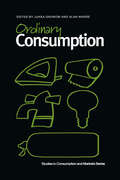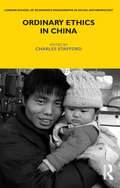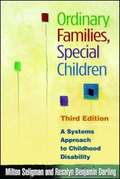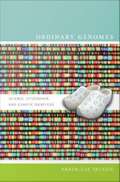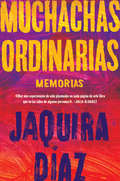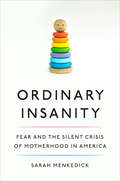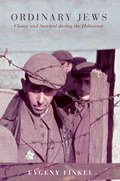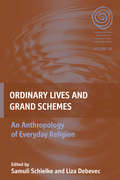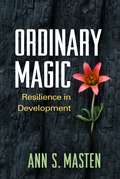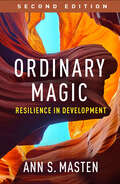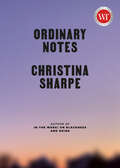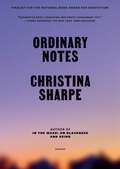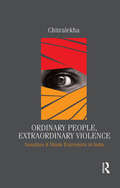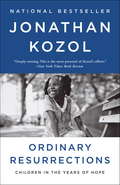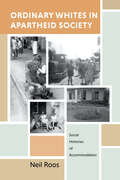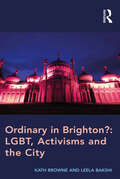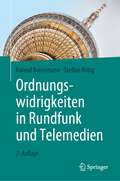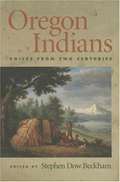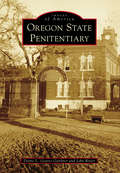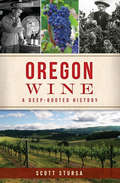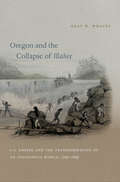- Table View
- List View
Ordinary Consumption (Studies in Consumption and Markets)
by Alan Warde Jukka GronowFirst published in 2001. Routledge is an imprint of Taylor & Francis, an informa company.
Ordinary Ethics in China (LSE Monographs on Social Anthropology)
by Charles StaffordDrawing on a wide range of anthropological case studies, this book focuses on ordinary ethics in contemporary China. The book examines the kinds of moral and ethical issues that emerge (sometimes almost unnoticed) in the flow of everyday life in Chinese communities.How are schoolchildren judged to be good or bad by their teachers and their peers - and how should a 'bad' student be dealt with? What exactly do children owe their parents, and how should this debt be repaid? Is it morally acceptable to be jealous if one's neighbours suddenly become rich? Should the wrongs of the past be forgotten, e.g. in the interests of communal harmony, or should they be dealt with now?In the case of China, such questions have obviously been shaped by the historical contexts against which they have been posed, and by the weight of various Chinese traditions. But this book approaches them on a human scale. More specifically, it approaches them from an anthropological perspective, based on participation in the flow of everyday life during ethnographic fieldwork in Chinese communities.
Ordinary Families, Special Children: A Systems Approach to Childhood Disability (3rd Edition)
by Milton Seligman Rosalyn Benjamin DarlingThis popular clinical reference and text provides a multisystems perspective on childhood disability and its effects on family life. The volume examines how child, family, ecological, and sociocultural variables intertwine to shape the ways families respond to disability, and how professionals can promote coping, adaptation, and empowerment. Accessible and engaging, the book integrates theory and research with vignettes and firsthand reflections from family members.
Ordinary Genomes: Science, Citizenship, and Genetic Identities
by Karen-Sue TaussigOrdinary Genomes is an ethnography of genomics, a global scientific enterprise, as it is understood and practiced in the Netherlands. Karen-Sue Taussig's analysis of the Dutch case illustrates how scientific knowledge and culture are entwined: Genetics may transform society, but society also transforms genetics. Taussig traces the experiences of Dutch people as they encounter genetics in research labs, clinics, the media, and everyday life. Through vivid descriptions of specific diagnostic processes, she illuminates the open and evolving nature of genetic categories, the ways that abnormal genetic diagnoses are normalized, and the ways that race, ethnicity, gender, and religion inform diagnoses. Taussig contends that in the Netherlands ideas about genetics are shaped by the desire for ordinariness and the commitment to tolerance, two highly-valued yet sometimes contradictory Dutch social ideals, as well as by Dutch history and concerns about immigration and European unification. She argues that the Dutch enable a social ideal of tolerance by demarcating and containing difference so as to minimize its social threat. It is within this particular construction of tolerance that the Dutch manage the meaning of genetic difference.
Ordinary Girls \ Muchachas ordinarias (Spanish edition): Memorias
by Jaquira DíazPara las muchachas que fuimos, para la muchacha que fui, para las muchachas de todo el mundo que son como nosotras solíamos ser. Para las muchachas que nunca se vieron reflejadas en los libros. Para las muchachas ordinarias.Jaquira Díaz siempre se encontró entre extremos en lugares permeados por la violencia. A pesar de añorar tener una familia unida y un hogar seguro, éstos eran difíciles de conseguir viviendo bajo los niveles de pobreza en el caserío Padre Rivera en Puerto Rico y en Miami Beach, sobre todo tras el diagnóstico de esquizofrenia de su madre y la subsiguiente ruptura familiar. El amor y apoyo de sus panas la mantuvieron a flote al encontrarse ante otra disyuntiva: su identidad y orgullo como puertorriqueña no dejaba cabida para su nueva identidad sexual.Cada página de Muchachas ordinarias brilla por su lirismo, crudeza y sensibilidad. Desde su lucha contra la depresión y el tortuoso camino que debió recorrer como sobreviviente de agresión sexual, pasando por el estado colonial actual de Puerto Rico, Díaz narra sus vivencias con increíble lucidez y brutal honestidad, trazando la ruta que la alejó de la desesperanza y la llevó hacia el amor y el deseo de convertirse en la muchacha que siempre quiso ser.Jaquira Díaz nació en Puerto Rico y se crió en Miami Beach. Su obra ha sido publicada en Rolling Stone, The Guardian, The New York Times Style Magazine e incluida en la antología The Best American Essays 2016, entre otros. Ha sido galardonada con el Whiting Award, la medalla de oro del Florida Book Awards y ha sido finalista de los Lambda Literary Awards. Divide su tiempo entre Montreal y Miami con su espose, le escritore Lars Horn.
Ordinary Insanity: Fear and the Silent Crisis of Motherhood in America
by Sarah MenkedickA groundbreaking exposé and diagnosis of the silent epidemic of fear afflicting new mothers, and a candid, feminist deep dive into the culture, science, history, and psychology of contemporary motherhood Anxiety among mothers is a growing but largely unrecognized crisis. In the transition to motherhood and the years that follow, countless women suffer from overwhelming feelings of fear, grief, and obsession that do not fit neatly within the outmoded category of &“postpartum depression.&” These women soon discover that there is precious little support or time for their care, even as expectations about what mothers should do and be continue to rise. Many struggle to distinguish normal worry from crippling madness in a culture in which their anxiety is often ignored, normalized, or, most dangerously, seen as taboo. Drawing on extensive research, numerous interviews, and the raw particulars of her own experience with anxiety, writer and mother Sarah Menkedick gives us a comprehensive examination of the biology, psychology, history, and societal conditions surrounding the crushing and life-limiting fear that has become the norm for so many. Woven into the stories of women&’s lives is an examination of the factors—such as the changing structure of the maternal brain, the ethically problematic ways risk is construed during pregnancy, and the marginalization of motherhood as an identity—that explore how motherhood came to be an experience so dominated by anxiety, and how mothers might reclaim it. Writing with profound empathy, visceral honesty, and deep understanding, Menkedick makes clear how critically we need to expand our awareness of, compassion for, and care for women&’s lives.
Ordinary Jews: Choice and Survival during the Holocaust
by Evgeny FinkelFocusing on the choices and actions of Jews during the Holocaust, Ordinary Jews examines the different patterns of behavior of civilians targeted by mass violence. Relying on rich archival material and hundreds of survivors' testimonies, Evgeny Finkel presents a new framework for understanding the survival strategies in which Jews engaged: cooperation and collaboration, coping and compliance, evasion, and resistance. Finkel compares Jews' behavior in three Jewish ghettos—Minsk, Kraków, and Białystok—and shows that Jews' responses to Nazi genocide varied based on their experiences with prewar policies that either promoted or discouraged their integration into non-Jewish society. Finkel demonstrates that while possible survival strategies were the same for everyone, individuals' choices varied across and within communities. In more cohesive and robust Jewish communities, coping—confronting the danger and trying to survive without leaving—was more organized and successful, while collaboration with the Nazis and attempts to escape the ghetto were minimal. In more heterogeneous Jewish communities, collaboration with the Nazis was more pervasive, while coping was disorganized. In localities with a history of peaceful interethnic relations, evasion was more widespread than in places where interethnic relations were hostile. State repression before WWII, to which local communities were subject, determined the viability of anti-Nazi Jewish resistance.Exploring the critical influences shaping the decisions made by Jews in Nazi-occupied eastern Europe, Ordinary Jews sheds new light on the dynamics of collective violence and genocide.
Ordinary Lives And Grand Schemes
by Samuli Schielke Liza DebevecEveryday practice of religion is complex in its nature, ambivalent and at times contradictory. The task of an anthropology of religious practice is therefore precisely to see how people navigate and make sense of that complexity, and what the significance of religious beliefs and practices in a given setting can be. Rather than putting everyday practice and normative doctrine on different analytical planes, the authors argue that the articulation of religious doctrine is also an everyday practice and must be understood as such.
Ordinary Lives: Studies in the Everyday
by Ben HighmoreThis new study from Ben Highmore looks at the seemingly banal world of objects, work, daily media, and food, and finds there a scintillating array of passionate experience. Through a series of case studies, and building on his previous work on the everyday, Highmore examines our relationship to familiar objects (a favourite chair), repetitive work (housework, typing), media (distracted television viewing and radio listening) and food (specifically the food of multicultural Britain). A chair allows him to consider the history of flat-pack furniture as well as the lively presence of inorganic ‘stuff’ in our daily lives. Distracted television watching and radio listening becomes one of the preconditions for experiencing wonder through the media. Ordinary Lives links the concrete study of routine existence to theoretical reflection on everyday life. The book discusses philosophers such as Jacques Rancière, William James and David Hume and combines them with autobiographical testimonies, historical research and the analysis of popular culture to investigate the minutiae of day-to-day life. Highmore argues that aesthetic experience is embedded in the mundane sensory world of everyday life. He asks the reader to reconsider the negative associations of habit and routine, focusing specifically on the intrinsic ambiguity of habit (habit, we find out, is both rigid and adaptive). Rather than ask ‘what does everyday life mean?’ this book asks ‘what does everyday life feel like and how do our sensual, emotional and temporal experiences interconnect and intersect?’ Ordinary Lives is an accessible, animated and engaging book that is ideally suited to both students and researchers working in cultural studies, media and communication and sociology.
Ordinary Magic
by Ann S. MastenFrom a pioneering researcher, this book synthesizes the best current knowledge on resilience in children and adolescents. Ann S. Masten explores what allows certain individuals to thrive and adapt despite adverse circumstances, such as poverty, chronic family problems, or exposure to trauma. Coverage encompasses the neurobiology of resilience as well as the role of major contexts of development: families, schools, and culture. Identifying key protective factors in early childhood and beyond, Masten provides a cogent framework for designing programs to promote resilience. Complex concepts are carefully defined and illustrated with real-world examples.
Ordinary Magic
by Ann S. MastenFrom a pioneering researcher, this book synthesizes the best current knowledge on resilience in children and adolescents. Ann S. Masten explores what allows certain individuals to thrive and adapt despite adverse circumstances, such as poverty, chronic family problems, or exposure to trauma. Coverage encompasses the neurobiology of resilience as well as the role of major contexts of development: families, schools, and culture. Identifying key protective factors in early childhood and beyond, Masten provides a cogent framework for designing programs to promote resilience. Complex concepts are carefully defined and illustrated with real-world examples.
Ordinary Magic: Resilience in Development
by Ann S. MastenFully updated with key advances in theory, methods, and research, the second edition of this landmark work features an expanded conceptual framework and a more global perspective on threats to human development, including climate change, war, poverty, racial injustice, and pandemics. Pioneering resilience expert Ann S. Masten illuminates the ordinary but powerful processes that allow many children exposed to trauma and adversity to survive, adapt, and even thrive. The book traces fundamental adaptive systems that have evolved and function synergistically at the neurobiological, psychological, social, community, and cultural levels. Using a range of case examples to illustrate complex concepts, Masten provides a cogent resilience framework for promoting positive development in children at risk. New to This Edition Advances in neurobiology, more international (including non-Western) findings and examples, new discussions of cultural identity development, up-to-date intervention research, and more. Heightened focus on the interactions of multiple systems--including families, schools, culture, and communities--in supporting children's resilience. Increased attention to the impact of structural inequality, poverty, and intergenerational trauma. Coverage of rapidly emerging threats--the risks posed to children by multisystem, cascading disasters, such as the COVID-19 pandemic.
Ordinary Notes
by Christina SharpeOne of The Millions&’ &“Most Anticipated Books of 2023One of The New York Times&’ &“19 Works of Nonfiction to Read This Spring&”A dazzlingly inventive, deeply moving, intellectually bracing exploration of pain and beauty, private memory and public monument, art and complexity in contemporary Black life.&“I wanted to write about silences and terror and acts that hover over generations, over centuries. I began by writing about my mother and grandmother.&” —from &“Note 18&” in Ordinary NotesA singular achievement, Ordinary Notes explores with immense care profound questions about loss, and the shapes of Black life that emerge in the wake. In a series of 248 brief and urgent notes that gather meaning as we read them, Christina Sharpe skillfully weaves artifacts from the past—public ones alongside others that are poignantly personal—with present-day realities and possible futures, intricately constructing an immersive portrait of everyday Black existence. Through the striking images and words in these pages, themes and tones echo: sometimes about life, art, language, beauty, memory; sometimes about history, photography, and literature—but always attending, with exquisite care, to the ordinary-extraordinary dimensions of Black life. At the heart of Ordinary Notes is the indelible presence of the author&’s mother, Ida Wright Sharpe. &“I learned to see in my mother&’s house,&” writes Sharpe. &“I learned how not to see in my mother&’s house . . . My mother gifted me a love of beauty, a love of words.&” Using these and other gifts and ways of seeing, Sharpe steadily summons a chorus of voices and experiences to become present on the page. She articulates and follows an aesthetic of "beauty as a method,&” collects entries from a community of thinkers towards a &“Dictionary of Untranslatable Blackness,&” and rigorously examines sites of memory and memorial. And in the process, she forges a new literary form, as multivalent as the ways of Black being it traces.
Ordinary Notes
by Christina SharpeA finalist for the National Book Award in NonfictionA finalist for the National Book Critics Circle Award in NonfictionNamed a Best Book of 2023 by The New York Times, NPR, New York magazine, Kirkus, and Barnes and NobleThe critically acclaimed author of In the Wake, “Christina Sharpe is a brilliant thinker who attends unflinchingly to the brutality of our current arrangements . . . and yet always finds a way to beauty and possibility” (Saidiya Hartman).A singular achievement, Ordinary Notes explores profound questions about loss and the shapes of Black life that emerge in the wake. In a series of 248 notes that gather meaning as we read them, Christina Sharpe skillfully weaves artifacts from the past—public ones alongside others that are poignantly personal—together with present realities and possible futures, intricately constructing an immersive portrait of everyday Black existence. The themes and tones that echo through these pages, sometimes about language, beauty, and memory, sometimes about history, art, photography, and literature, always attend, with exquisite care, to the ordinary-extraordinary dimensions of Black life.At the heart of Ordinary Notes is the indelible presence of the author’s mother, Ida Wright Sharpe. “I learned to see in my mother’s house,” writes Sharpe. “I learned how not to see in my mother’s house . . . My mother gifted me a love of beauty, a love of words.” Using these gifts and other ways of seeing, Sharpe steadily summons a chorus of voices and experiences to the page. She practices an aesthetic of “beauty as a method,” collects entries from a community of thinkers toward a “Dictionary of Untranslatable Blackness,” and rigorously examines sites of memory and memorial. And in the process, she forges a brilliant new literary form, as multivalent as the ways of Black being it traces.Color art throughout
Ordinary People, Extraordinary Violence: Naxalites and Hindu Extremists in India
by ChitralekhaThe book engages with an urgent and disturbing question: how are ordinary people readied to willingly kill others in the name of a cause? It compares narratives of actors in domains often assumed incomparable in academic discourse: Naxalites studied within the framework of peasant rebellion, social movement or recently even terrorism, and Hindu rioters viewed mostly under the broad rubric of ethnic violence. The book draws from the author’s extensive and painstaking fieldwork, first with Naxalite armed cadre across seven districts in Jharkhand and Bihar, and later with participants in the 2002 riots in Gujarat. Viewed from the standpoint of the perpetrator or foot soldier, the book bridges hitherto sacrosanct boundaries between left-extremist and communal violence, making available a whole new dimension to the study of social mobilisation, the politics of identity and, with far reaching implications, discovers deep commonalities in the life-worlds and aspirations of those motivated to kill in the name of a cause in apparently disparate contexts.The findings of this compelling analysis of human actors — ordinary people driven to extraordinary violence — will interest the informed general reader, as also those interested in sociology, politics, violence studies, ethnic movements, Naxalism, policy studies, and peace & conflict studies.
Ordinary Resurrections: Children in the Years of Hope
by Jonathan KozolIn a stirring departure from his earlier work, Jonathan Kozol has written his most personal and hopeful book to date, an energized and unexpected answer to the bleakness of Death at an Early Age, the prize-winning classic that he published more than 30 years ago.Like his most recent book, Amazing Grace, this work also takes place in New York's South Bronx; but it is a markedly different book in mood and vantage point, because we see life this time through the eyes of children, not, as the author puts it, from the perspective of a grown-up man encumbered with a Harvard education. Here, too, we see devoted teachers in a good but underfunded public elementary school that manages, against all odds, to be a warm, inviting, and protective place; and we see the children also in the intimate religious setting of a church in which they are watched over by the vigilant grandmothers of the neighborhood and by a priest whose ministry is, first and foremost, to the very young.A work of guarded optimism that avoids polemic and the fevered ideologies of partisan debate, Ordinary Resurrections is a book about the little miracles of stubbornly persistent innocence in children who are still unsoiled by the world and still can view their place within it without cynicism or despair. Sometimes playful, sometimes jubilantly funny, and sometimes profoundly sad, they're sensitive children, by and large -- complex and morally insightful -- and their ethical vitality denounces and subverts the racially charged labels that the world of grown-up expertise too frequently assigns to them.The author's personal involvement with specific children deepens as the narrative evolves. A Jewish man, now 63 years old, he finds his own religious speculations growing interwoven with the moral and religious explorations of the children, some of whom have been his friends for nearly seven years. The children change, of course, from year to year as they learn more about the world; but the author is changed also by the generous and tender ways in which the children, step by step, unlock their secrets and unveil the mysteries of their belief to him.Salvation in these stories comes not from the promises of politicians or the claims of sociology but from the ordinary resurrections that take place routinely in the hearts of children. "We all lie down," a theologian tells the author. "We all rise up. We do this every day." So, too, when given a fair chance, do many of the undervalued urban children of our nation. In this book, we see some beautiful children as they rise, and rise again.From the Hardcover edition.
Ordinary Time: Cycles in Marriage, Faith, and Renewal
by Nancy MairsIn a series of personal essays, Nancy Mairs writes about her lifelong relationship with spirituality and organized religion. Raised a Congregationalist in New England, she converts to Catholicism as an adult. The essays deal frontally with issues in the author's marriage, including a series of infidelities; forgiveness is a major theme.
Ordinary Whites in Apartheid Society: Social Histories of Accommodation
by Neil RoosHow were whites implicated in and shaped by apartheid culture and society, and how did they contribute to it? In Ordinary Whites in Apartheid Society, historian Neil Roos traces the lives of ordinary white people in South Africa during the apartheid years, beginning in 1948 when the National Party swept into power on the back of its catchall apartheid slogan. Drawing on his own family's story and others, Roos explores how working-class whites frequently defied particular aspects of the apartheid state but seldom opposed or even acknowledged the idea of racial supremacy, which lay at the heart of the apartheid society. This cognitive dissonance afforded them a way to simultaneously accommodate and oppose apartheid and allowed them to later claim they never supported the apartheid system. Ordinary Whites in Apartheid Society offers a telling reminder that the politics and practice of race, in this case apartheid-era whiteness, derive not only from the top, but also from the bottom.
Ordinary Whites in Apartheid Society: Social Histories of Accommodation
by Neil RoosHow were whites implicated in and shaped by apartheid culture and society, and how did they contribute to it? In Ordinary Whites in Apartheid Society, historian Neil Roos traces the lives of ordinary white people in South Africa during the apartheid years, beginning in 1948 when the National Party swept into power on the back of its catchall apartheid slogan. Drawing on his own family's story and others, Roos explores how working-class whites frequently defied particular aspects of the apartheid state but seldom opposed or even acknowledged the idea of racial supremacy, which lay at the heart of the apartheid society. This cognitive dissonance afforded them a way to simultaneously accommodate and oppose apartheid and allowed them to later claim they never supported the apartheid system. Ordinary Whites in Apartheid Society offers a telling reminder that the politics and practice of race, in this case apartheid-era whiteness, derive not only from the top, but also from the bottom.
Ordinary in Brighton?: Lgbt, Activisms And The City
by Leela Bakshi Kath BrowneOrdinary in Brighton? offers the first large scale examination of the impact of the UK equalities legislation on lesbian, gay, bi- and trans (LGBT) lives, and the effects of these changes on LGBT political activism. Using the participatory research project, Count Me In Too, this book investigates the material issues of social/spatial injustice that were pertinent for some - but not all- LGBT people, and explores activisms working in partnership that operated with/within the state. Ordinary in Brighton? explores the unevenly felt consequences of assimilation and inclusion in a city that was compelled to provide a place (literally and figuratively) for LGBT people. Brighton itself is understood to be exceptional, and exploring this specific location provides insights into how place operates as constitutive of lives and activisms. Despite its placing as ’the gay capital’ and its long history as a favoured location of LGBT people, there is very little academic or popular literature published about this city. This book offers insights into the first decade of the 21st century when sexual and gender dissidents supposedly became ordinary here, rather than exceptional and transgressive. It argues that geographical imaginings of this city as the ’gay capital’ formed activisms that sought positive social change for LGBT people. The possibilities of legislative change and urban inclusivities enabled some LGBT people to live ordinary lives, but this potential existed in tension with normalisations and exclusions. Alongside the necessary critiques, Ordinary in Brighton? asks for conceptualisations of the creative and co-operative possibilities of ordinariness. The book concludes by differentiating the exclusionary ideals of normalisation from the possibilities of ordinariness, which has the potential to render a range of people not only in-place, but commonplace. All royalties from this book will be donated to Allsorts Youth Project, Brighton & Hove LGBT Switchboa
Ordnungswidrigkeiten in Rundfunk und Telemedien
by Roland Bornemann Steffen RittigDas Rechtshandbuch stellt die Ahndung und Verfolgung von Ordnungswidrigkeiten in Online-Medien (Rundfunk und Telemedien) mit ihren Besonderheiten dar. Es konzentriert sich auf die Gesichtspunkte, die in der Praxis eine Rolle spielen. Damit versetzt es Leser in die Lage, einen durchschnittlichen Alltagsfall im rundfunkrechtlichen Bußgeldverfahren ohne weitere Spezialliteratur zu lösen. Das Werk ist unverzichtbar für die Compliance bei privaten Rundfunkveranstaltern, Anbietern von rundfunkähnlichen Telemedien, Medienplattformen, Benutzeroberflächen, Medienintermediären und sonstigen Telemedien. Es wendet sich zudem an Studierende mit medienrechtlichem Studienschwerpunkt, an Landesmedienanstalten als nach §§ 35, 36 OWiG zuständige Verwaltungsbehörden sowie an Staatsanwaltschaften und Strafgerichte, aber ebenso und nicht zuletzt an die Verteidigerinnen und Verteidiger im Bußgeldverfahren.
Oregon Indians: Voices from Two Centuries
by Stephen Dow BeckhamFrom their first encounters with European traders along the coast to their struggles for the restoration of tribal rights in the 1980s, the Indians or Oregon have managed to hold onto their identity in a constantly changing world. In this book Beckham tells the story of Oregon's Indians through letters, diaries, memoirs, newspaper articles, and legal documents. Beckham begins each entry by setting it in context, often giving biographical information about the people involved in a particular incident. The book is very sympathetic toward Native American perspective, and reveals how Oregon's Indians were cheated and abused again and again for more than two hundred years.
Oregon State Penitentiary
by John Ritter Diane L. Goeres-GardnerAs the only maximum-security prison in the state, the Oregon State Penitentiary (OSP) has housed some of the most violent criminals on the West Coast, including brutal serial killers Charley Panzram in 1915 and Jerry Brudos in 1969. Sixty men have been executed inside OSP. The prison was originally built in Portland in 1851 but moved to Salem 15 years later, after Oregon became a state. From that time forward, the Oregon State Penitentiary grew from 23 prisoners in 1866 to 1,912 by 1992. The penitentiary suffered several serious fires and riots. On March 9, 1968, the most expensive riot ever experienced in the United States flared inside the walls, causing over $2.5 million in damages. Numerous escapes plagued the prison until 1970, when security measures were tightened. The most famous escape involved Harry Tracy and David Merrill in 1902.
Oregon Wine: A Deep-Rooted History (American Palate)
by Scott StursaThe history of winemaking in Oregon is steeped in legends so well known they've become gospel, but reality is even more fascinating. Discover the truth about who opened the state's first commercial winery and the real origin of Willamette Valley's famed Pinot Noir. Learn about Portland's daring Italian Americans, who kept home wineries during Prohibition, and the flourishing agriculture that contributed to the popularity of fruit wine. From the nineteenth-century winemakers through the modern industry that now includes more than seven hundred wineries, places like HillCrest and The Eyrie have been serving Oregonians for a half century. Uncover the forgotten roots of Oregon wine with author Scott Stursa and raise a glass to its prosperous future.
Oregon and the Collapse of Illahee: U. S. Empire and the Transformation of an Indigenous World, 1792-1859
by Gray H. WhaleyModern western Oregon was a crucial site of imperial competition in North America during the formative decades of the United States. In this book, Gray Whaley examines relations among newcomers and between newcomers and Native peoples--focusing on political sovereignty, religion, trade, sexuality, and the land--from initial encounters to Oregon's statehood. He emphasizes Native perspectives, using the Chinook word Illahee (homeland) to refer to the indigenous world he examines. Whaley argues that the process of Oregon's founding is best understood as a contest between the British Empire and a nascent American one, with Oregon's Native people and their lands at the heart of the conflict. He identifies race, republicanism, liberal economics, and violence as the key ideological and practical components of American settler-colonialism. Native peoples faced capriciousness, demographic collapse, and attempted genocide, but they fought to preserve Illahee even as external forces caused the collapse of their world. Whaley's analysis compellingly challenges standard accounts of the quintessential antebellum "Promised Land."
